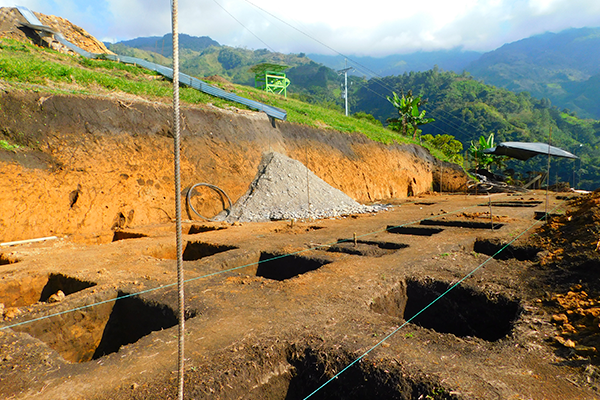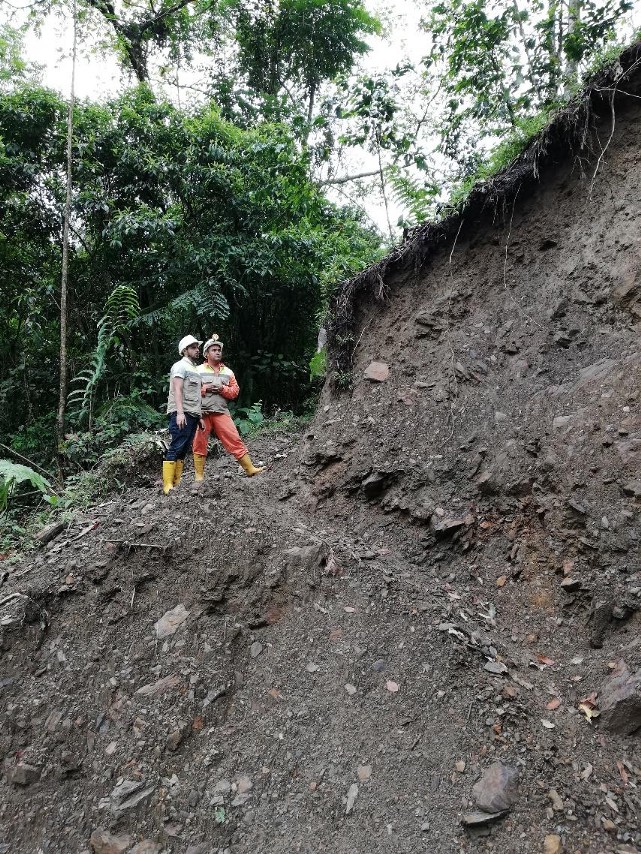Interview with Daniel Lopez Environmental Engineer, currently the Director of the Environmental Area of the Guayaquil Mining Project. Daniel is in charge of ensuring the protection of fauna, flora, water resources, air protection and impact mitigation, correction and compensation of environmental impacts.
“We know that every human action produces positive or negative impacts, and what we want is that the positive impacts that we generate here at the mining project are intensified, and that the negative ones are mitigated or corrected”.
Fundamental parts of the Environmental Area
Water resource protection
We are in charge of protecting water resources and for this we have some very special programs required by the “corporación autónoma regional” (regional autonomous corporation), which is the issue of gauging.
But, what are gauging? The gauging is a set of techniques to watch over the quality of the water and to take measurements of how much water we have in the streams of the mining project. Currently we have 2 of our interest which are the Morena and Cartagena, the main one is the Morena and from it we are going to capture our water for the process of the benefit plant and for domestic use.
We are also going to discharge all the domestic and industrial wastewater into the same stream, and the environmental department is making sure that the water is treated correctly.
At the moment we only have domestic wastewater, which we use to wash, wash ourselves, take showers, for cooking, for human consumption; at the moment we do not have industrial wastewater because we do not have a processing plant and because we have not built a WWTP.
The WWTP is a gigantic impact mitigation, it is the one that will ensure that the water we collect after the process, since it comes out with some chemicals, which comes out with some clay material, that produces turbidity in the water and can generate some negative impacts on the environment.
So, what does the WWTP do? The WWTP is the “Waste Water Treatment Plant” which is in charge of treating our water, there is a part that is going to be re-circulated from this treated water so as not to capture all the water from the water source, the intention is to ensure that the least water resource is captured so as not to affect the neighboring communities.
Subsequent to the treatment, this water will be discharged under some parameters consigned under a Colombian resolution that is 06 31 of 2015, in which they indicate that we have several parameters that are of VO of QO biochemical oxygen demand, how much organic load we are discharging …etc.
If we exceed these values we are going to have some inconveniences with the company and with the regulatory bodies, but the idea is that we do not reach that, that the WWTP works optimally and we can discharge water with the ideal characteristics.

Physical-chemical verification of water quality
It is very important for us to know that the “corporación autónoma regional” requires us to have certain physical-chemical characterizations, last month, on February 24, 25 and 26, 2021 we did a physical-chemical characterization in four points.
- Domestic wastewater discharges, how the water we are treating at the moment is coming out, which is the only water we are needing.
- Another characterization is how the water is coming out of the Colombia mine, this comes out with some minerals, it also has some parameters indicated only for the mine.
- We also made a physical-chemical characterization at the catchment point that we have as such, we are building the intake.
- We captured how it is being returned to the environment.
These are the four points that were taken last month and the truth is that we are waiting for the response because this was done with a private company, specialist and certified as such at national level.
Solid waste management
We also manage solid waste, the idea as such is first: the first stage is to educate the population, because here in Colombia it is not common for people to recycle, for people to see waste as an economic opportunity, to give back to the environment as such a retribution.
Here we simply dispose of all the waste wherever it falls, so from the environmental area, we have wanted first to educate our workers in the segregation of solid waste.
To do this, we have ecological points as we call them here, which are bins of various colors which are classified into metals, glass, plastic, paper, cardboard, hazardous waste.
The first thing we want is for them to understand the importance of separating, which is the first line of this chain, also from the environmental area we have the collection, transfer and transportation.
We collect this waste from the ecological points and dispose it in our waste room. Once in the waste room, we finish sorting the waste, which has to be done manually because the workers still do not sort it properly in each of the bins.
Once sorted, we have our containers with the amount of paper, the amount of plastic, etc. After that, we sell the ones that can be marketed.
We also sell them to people nearby to leave the money in the town, and they are like intermediaries for the larger companies that collect this waste and treat it appropriately.
On the other hand, the waste that we cannot sell, that cannot be recovered, we dispose of in the sanitary landfill that is three hours away from here. At this point we have a very big problem and it is the low frequency of waste collection by the municipal government, the population does not have a weekly biweekly coverage, sometimes it takes two months to collect the garbage because we are very far from the municipal capital.
Waste programs
We also have several programs for the use of waste; we have a composting program for organic waste that biodegrades more quickly and with this we produce organic compost which is useful for plants, for crops.
We have programs for plastics, we have a plastic shredder, whose main function is to reduce volumes, because plastics, such as soda bottles, soft drink bottles, generate a very large volume, and we do not have giant warehouses to store all this waste.
In this case, what we do is, first to reduce volume and second to make a primary treatment of these plastics to be able to commercialize them with a much higher value.
We have home garden programs, as our CEO Fernando mentioned, we have a home garden where we grow our own food that we consume right here: onions, tomatoes, corn, bananas, avocados, the land we have in the project is very fertile and can give us a lot of fruit.
We also have a reforestation program. In the reforestation program the company has wanted to give a lot of importance to it, it has wanted to be very concise in that. So far we have planted 3,086 trees, which is not a small amount at all. We have the obligation to plant 50 trees per year, for 10 years, we are oversized in this, but this is a very good thing, because it is a matter of environmental compensation for the impacts we generate.

We want to be planting approximately 800 thousand trees annually, because we know that this is fundamental in any ecosystem and is of great environmental interest, so we are doing more than we should.
We also manage everything related to the recovery of slopes to prevent erosion and we also accompany Carlos de infraestructura in the recovery of vegetation on the slopes.
We transplant vegetation from some sites of interest and it is gradually recovering on the slopes; and the slopes that need a different recovery, such as the 90-degree slopes, we carry out a more technical process with the planting of seeds. And everything that is planted is native, which are plants from here.
It is also worth mentioning that we manage hazardous waste, hazardous waste management, biological waste, and used oils; we know that the management of used oils is essential so as not to contaminate water sources.
This is done with an accredited company, the company is called ASEVICAL, we give them a primary management in the hazardous waste room and from there we call the company as such accredited for the management and they make the correct disposal.
We also manage everything related to environmental education, both with the neighboring populations, with the surrounding population and with our workers, so here we teach them to take care of the water sources, not to kill the animals, here there was a very degrading culture where they saw a snake or any animal and they killed it at once.

What we want them to understand is that each animal has its ecological function in the environment, we have had talks with ophidians so that they know when they find a snake how to act in order not to kill it. To know if this snake is venomous or not, we also teach them how to differentiate this, which is extremely important.
We also provide education on Colombian environmental and mining regulations with the national mining agency and Corpocaldas.
We want to talk about the BICIGOLD program, in connection with the Laura’s social program we also educate from the environmental point of view, we have also had tree planting with the children.
We created the environmental policy of the mining project which is, as we have said before, everything that is the care and protection of the environment.
We have to take care of this paradise and continue working for green mining.

